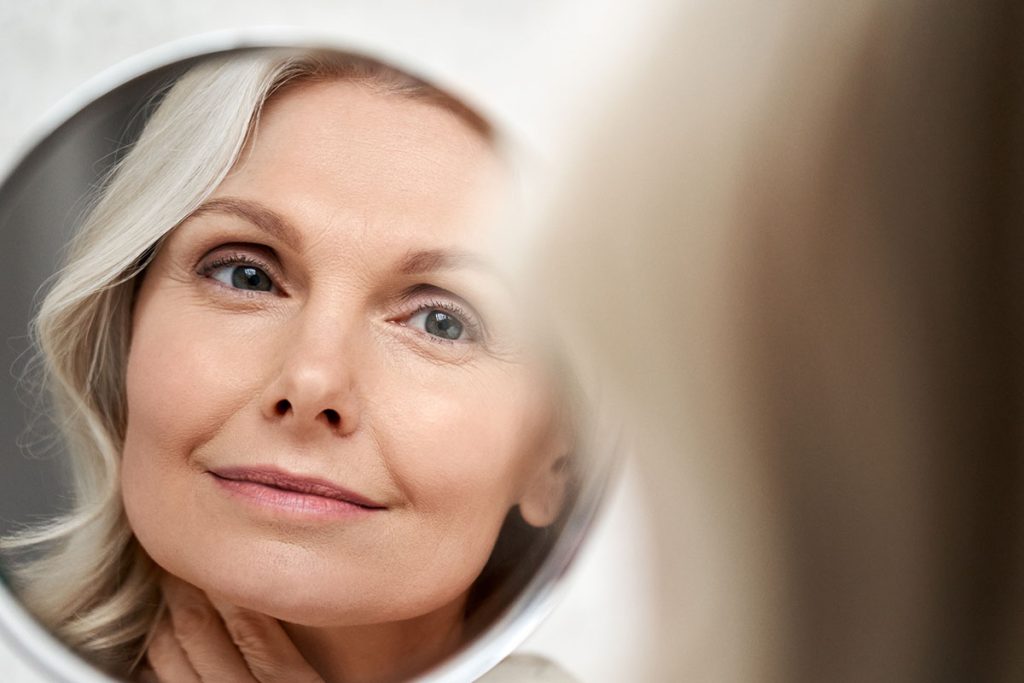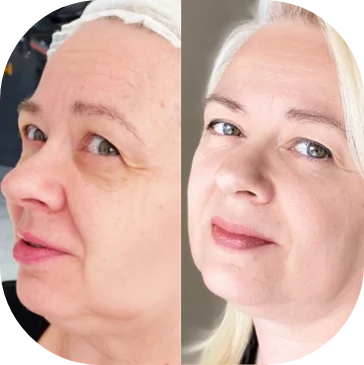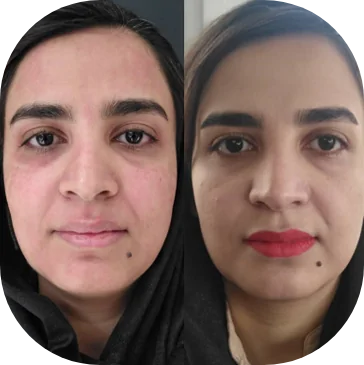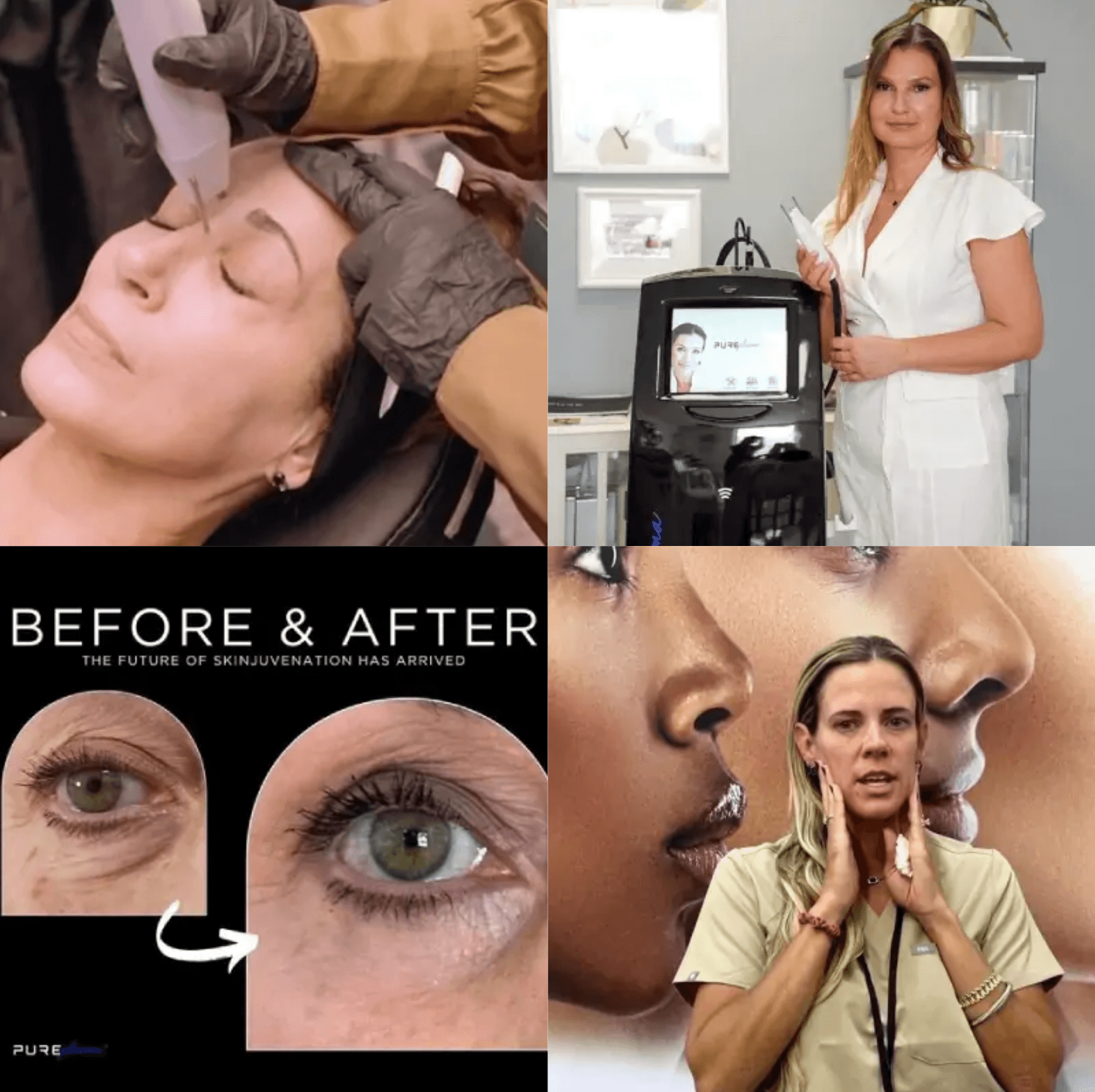How Plasma Stimulates Skin Regeneration

Plasma skin regeneration (PSR) is a non-invasive procedure that involves the use of plasma to reduce fine lines, atrophic scars, wrinkles, sun spots, and sagging. It can also be used to plump up thin lips. In PSR, low-energy nitrogen plasma beams are emitted onto targeted of skin to stimulate collagen, elastin, and hyaluronic acid production. All of these components are essential to maintaining smooth and healthy-looking skin. PSR offers patients a chance to achieve the skin of their youth with only micro-injuries that quickly heal and lead to long-lasting results.
PurePlasma is an FDA-approved device and one of the latest innovations that utilize nitrogen plasma for skin rejuvenation. Our lightweight machine comprises only two parts and no assembly is required. It can be adjusted to energy levels anywhere between 0.5 and 4 joules for accurate, safe application. Unlike CO2 lasers, there have been no reports of hypopigmentation with the use of PSR. It is also more versatile- it is safe to use around the eyes, eyelids, face, and neck. (1)
To find out more, call us at (877) 535-7873 or fill out our contact form with your inquiry, and we can get back to you with more information on our state-of-the-art equipment.
What is Plasma?
When a gas is heated to extremely high temperatures, it becomes plasma, the fourth state of matter. When a gas changes its state to plasma, its electrons completely separate from their atoms. Due to this law in physics, nitrogen plasma has a negative charge.
You can find plasma naturally within lightning bolts and aurora borealis that can be visible in the northern hemisphere during their winter season. In both of these phenomena, some plasma is created due to the energization of atoms within the air. Although it is rarely found on Earth, it makes up about 99% of our universe. In a PurePlasma device, only a tiny microbeam of plasma is applied to patients’ skin.
How Does Plasma Rejuvenate Skin?
Plasma microbeams create micro-injuries that start up the skin’s natural healing mechanisms. Specifically, plasma targets the papillary dermis layer of the skin. (2) This layer is mainly composed of fibroblasts– the cells responsible for creating connective proteins like collagen, elastin, and hyaluronic acid. When the papillary dermis experiences injury, fibroblasts accelerate the production of these proteins. Each of them serves similar functions for the skin:
- Collagen- provides rigidity and structure for the skin
- Elastin- allows the skin to stretch and recoil
- Hyaluronic acid- helps the skin retain moisture
Over the course of several months, patients can expect to see tighter, firmer, more youthful skin due to an abundance of these proteins.
Plasma skin regeneration treatments also leave the outermost layer of skin, the epidermis, completely intact. The epidermal layer serves as a natural dressing for the injuries in the dermis and helps to shorten the recovery process. (2)
How Does Plasma Reduce Scarring?
How Does PSR Affect Different Skin Types?
All skin types can be categorized from type I to type VI on a system called the Fitzpatrick Scale. Each type exhibits different characteristics that distinguish it from other types. For example, people with type I, II, and III sunburn much more easily than people with type IV, V, and VI. Here is a general idea of how the scale works:
- Type I- very pale and burns easily.
- Type II- Fair and usually burns.
- Type III- Almost olive-toned and can tan gradually.
- Type IV- Olive tone/medium brown and can tan very easily
- Type V- Brown and rarely burns
- Type VI- Dark brown and never burns
People with darker skin types have often found it more difficult to find skin rejuvenation treatments that work well for them. For many years, the effects of laser skin resurfacing treatments, for instance, were mostly studied on people with lighter skin tones. And more recently, certain types of laser resurfacing have been found to cause post-inflammatory hyperpigmentation (PIH) in people with skin types IV through VI. (3) In contrast, the latest research indicates that nitrogen plasma treatments are much safer for people with darker skin. This is due to the lower amount of energy used which causes less skin damage overall. (4)
Candidates
Plasma skin regeneration can treat people with mild-to moderate wrinkles around the eyes, (4) mouth, cheeks, brows, forehead, chin, and neck. People with sun spots, atrophic scars, and thin lips may also benefit from the protein production stimulated by PSR. The ideal candidate should have all medical conditions well-managed, have no conditions that impede skin healing, and have realistic expectations of their results. Patients who have experienced viral outbreaks will be treated with an antiviral medication prior to the procedure to prevent any outbreaks.
How to Prep for PSR
Although plasma skin regeneration isn’t invasive, it still requires some preparation to ensure that your skin stays as healthy as possible. Patients should avoid tanning, spray tans, tanning beds, dermal fillers, topical irritants such as facial acids, and microneedling treatments for about 4 weeks before their treatment. You should avoid plucking or waxing the treatment area for at least two weeks before your procedure date. Finally, use a sunscreen of SPF 30 or more for about a month before your procedure if you plan on staying outside for long periods of time.
Procedure Steps
Before your procedure, make sure to remove any makeup or creams on your face with mild soap. A medical professional will have you sit comfortably in a chair and apply topical numbing cream to the designated areas. They will then apply short pulses of nitrogen plasma to these areas.
With a PurePlasma device, gas within the nitrogen tank passes through electrodes that turn the gas into plasma. It travels through a small tube in the handheld device to the skin for precise targeting. The device can disperse different energy levels according to various skin textures. The entire treatment only takes about 15-30 minutes.
Recovery
You may experience redness and swelling for the first few hours after the procedure. You can apply a cold compress that isn’t wet to the skin to relieve any discomfort. The swelling is a normal part of healing and will reduce significantly after 24 hours.
Within the next few days, your skin may scab, peel and itch as a result of the micro-injuries produced by the plasma pulses. You may also experience temporary hyperpigmentation– or dark patches where the treatment was performed. (4) During this process, it’s important that you don’t exfoliate, moisturize, or pick at your skin. Once your skin stops peeling by the end of the first week, you will be able to use makeup, creams, and moisturizer. For the following 6 weeks, you should stay out of direct sunlight and/or use a sunscreen of SPF 30 or more.
Benefits
Utilizing plasma is the next level in skin rejuvenation; there are many more benefits to consider besides aesthetic results:
- Full recovery only takes one week. (2)
- Only topical anesthetic is required.
- Each treatment only takes 15-30 minutes.
- Final results can be seen in 3-4 weeks.
- Results continue to improve 10-12 months after treatment.
- Reduced appearance of wrinkles, fine lines, and atrophic scars.
- Increased elasticity of the skin.
- Less skin damage than CO2 lasers (1)
Real Results with PurePlasma
Once the peeling subsides in the treated areas, you can expect to see tightened, radiant skin underneath. Over the next 10-12 months, your skin will gradually repair itself more efficiently due to the dramatic increase in collagen, elastin, and hyaluronic acid production. This process will improve your skin’s elasticity, smoothness, and texture. Your skin is likely to retain moisture much more efficiently. You can expect to see atrophic scars and facial blemishes slowly fade due to the rearrangement of collagen. PurePlasma treatment can also serve to provide additional volume to thin lips.
To discover more about the benefits of PurePlasma non-invasive skin rejuvenation, call (877) 535-7873 or use our online contact form to submit an inquiry.
FAQ
Will plasma skin regeneration leave scarring?
In PSR, the topmost layer of the skin, the epidermis, is left undamaged, so there is less risk of scarring. (2) You may experience hyperpigmentation that will fade within a few days. (4) After one session, the fibroblasts in your skin will continue to boost the production of connective proteins for the next 10-12 months, so scarring is highly unlikely.
How many treatments of plasma skin regeneration are needed?
Most patients will need only 1 to 4 treatments, depending on how much skin improvement they desire. For patients looking to get several treatments, it is recommended that they wait 2 months between sessions.
Can plasma skin regeneration reduce severe wrinkling?
Plasma skin regeneration is only effective for mild-to-moderate lines and wrinkles in the face and neck.
Does plasma skin regeneration hurt?
A trained technician will apply a numbing cream to the treatment areas prior to applying plasma energy to the skin. Some patients describe mild discomfort during the procedure, but find it very tolerable. In the days following treatment, you’ll experience some mild swelling and itchiness.
Should I exfoliate after plasma skin regeneration?
You should avoid exfoliating products for at least 2 weeks after the procedure. The skin should peel naturally so that healing occurs at an optimal rate.
References
- Foster KW, Moy RL, Fincher EF. Advances in plasma skin regeneration. Journal of Cosmetic Dermatology. 2008;7(3):169-179. doi:https://doi.org/10.1111/j.1473-2165.2008.00385.x
- Almohammad A, Brad B, Owayda AM. The Effectiveness of Plasma Skin Regeneration (PSR) in the Treatment of Chronic Cleft Lip Scars in an Adult Syrian Sample: A Cohort Study on a Novel Technique. Cureus. 2022;14(12):e32989. Published 2022 Dec 27. doi:10.7759/cureus.32989
- Sriprachya-anunt S, Marchell NL, Fitzpatrick RE, Goldman MP, Rostan EF. Facial resurfacing in patients with Fitzpatrick skin type IV. Lasers in Surgery and Medicine. 2002;30(2):86-92. doi:https://doi.org/10.1002/lsm.10012
- Theppornpitak N, Udompataikul M, Chalermchai T, Ophaswongse S, Limtanyakul P. Nitrogen plasma skin regeneration for the treatment of mild‐to‐moderate periorbital wrinkles: A prospective, randomized, controlled evaluator‐blinded trial. Journal of Cosmetic Dermatology. 2018;18(1):163-168. doi:https://doi.org/10.1111/jocd.12767




